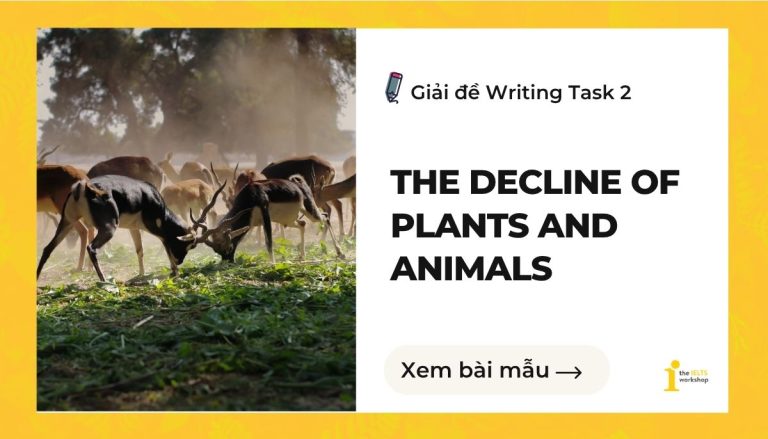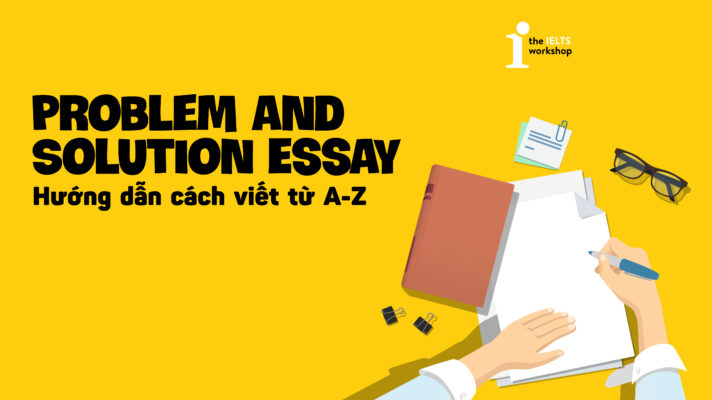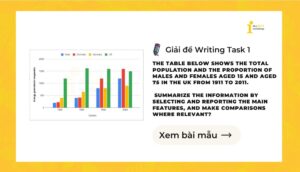The decline of plants and animals là một chủ đề thường gặp trong IELTS Writing Task 2, đặc biệt dưới dạng câu hỏi yêu cầu phân tích nguyên nhân và đề xuất giải pháp. Trong bài viết này, thầy Nguyễn Quang Nhật đến từ The IELTS Workshop sẽ hướng dẫn bạn cách tiếp cận logic và hiệu quả với dạng bài này, thông qua hệ thống luận điểm chặt chẽ và ví dụ minh hoạ sát thực tế.
1. Phân tích
1.1. Đề bài The decline of plants and animals trong IELTS Writing Task 2
In many countries, the number of plants and animals is declining. Why do you think it is happening ? How to solve ?
(Tại nhiều quốc gia, số lượng cây trồng và động vật đang ngày càng suy giảm. Theo bạn, vì sao lại có hiện tượng này? Làm thế nào để giải quyết vấn đề này?)
1.2. Phân tích đề bài
- Dạng bài: Causes and Solutions
- Triển khai dạng bài
Đề bài yêu cầu phân tích nguyên nhân và đề xuất giải pháp cho hiện tượng suy giảm số lượng thực vật và động vật.
→ Với dạng bài này, bạn nên triển khai 2 đoạn thân bài:
- Body 1: Trình bày các nguyên nhân chính dẫn đến sự suy giảm.
- Body 2: Đề xuất các giải pháp khả thi để khắc phục tình trạng này.
Lưu ý: Cần đảm bảo lập luận logic, ví dụ cụ thể và liên kết rõ ràng giữa nguyên nhân và giải pháp.
Xem thêm: Hướng dẫn A-Z cách cách viết Problem and Solution Essay trong IELTS Writing Task 2
1.3. Dàn bài chi tiết
Introduction
- Paraphrase đề bài:
→ Many countries are witnessing a decline in the number of plant and animal species. - Câu dẫn vào bài:
→ This situation can be attributed to several causes, and in this essay, practical solutions to mitigate the issue will be proposed. - Dịch:
→ Nhiều quốc gia đang chứng kiến sự suy giảm về số lượng các loài thực vật và động vật. Tình trạng này bắt nguồn từ nhiều nguyên nhân, và trong bài viết này, các giải pháp thực tiễn nhằm khắc phục vấn đề sẽ được đề xuất.
Body Paragraph 1: Causes
Nguyên nhân 1: Phá huỷ môi trường sống để phát triển kinh tế
- Các quốc gia phát triển cho phép phá rừng, nông nghiệp công nghiệp, khai thác tài nguyên, mở rộng đô thị.
- → Dẫn đến mất môi trường sống, sinh vật dễ bị tuyệt chủng, bị săn bắt trái phép.
- Cấu trúc gợi ý:
→ To stimulate economic growth, many resource-rich developing nations often allow environmentally harmful activities, which encroach upon natural ecosystems.
Nguyên nhân 2: Ô nhiễm môi trường do hoạt động của con người
- Khí thải, chất thải công nghiệp đầu độc sông hồ, hủy hoại chuỗi thức ăn.
- Biến đổi khí hậu → hạn hán, thời tiết cực đoan → sinh vật khó thích nghi, kể cả trong môi trường sống tự nhiên.
- Cấu trúc gợi ý:
→ Another key factor is environmental degradation resulting from human activities.
Body Paragraph 2: Solutions
Giải pháp 1: Tăng cường luật pháp & phạt nặng
- Ban hành quy định nghiêm ngặt hơn về sử dụng đất và bảo vệ môi trường.
- Áp dụng hình phạt cao để răn đe hành vi phá rừng, săn bắt trái phép, ô nhiễm công nghiệp.
- Cấu trúc gợi ý:
→ The most immediate measure would be to implement stricter regulations and impose hefty fines.
Giải pháp 2: Hợp tác công – tư, hỗ trợ doanh nghiệp xanh
- Chính phủ nên khuyến khích doanh nghiệp cùng tham gia bảo vệ môi trường.
- Cung cấp ưu đãi thuế, trợ cấp đầu tư xanh cho các dự án: trồng rừng, năng lượng sạch, quản lý chất thải.
- Mục tiêu: khôi phục hệ sinh thái và hướng doanh nghiệp đến phát triển bền vững.
- Cấu trúc gợi ý:
→ Governments should encourage public-private partnerships and offer tax incentives for green initiatives.
Conclusion
Tóm lại nguyên nhân: Khai thác tài nguyên vì mục tiêu kinh tế + thiệt hại môi trường do con người gây ra.
Tóm lại giải pháp: Chính phủ cần ban hành luật mạnh mẽ + phối hợp với doanh nghiệp để bảo vệ đa dạng sinh học.
Cấu trúc gợi ý:
→ Through strong governmental regulation and collaboration with the private sector, this crisis can be mitigated.
2. Bài mẫu (Sample)
Many nations are witnessing a significant decline in the number of species biodiversity, especially among native plant and animal species. This phenomenon can be attributed to several reasons, including the demolition of natural living environments and rising man-made environmental issues and some viable solutions that governments can adopt to alleviate the situation will be outlined in this essay.
There are two main contributors to the alarming decline in biodiversity. One major factor is the widespread destruction of natural habitats driven by economic development. To stimulate economic growth, many resource-rich developing nations often allow environmentally harmful activities, such as large-scale deforestation, industrial farming, oil drilling, and urban sprawl, encroaching upon ecosystems. This encroachment can leave countless species homeless and vulnerable to illegal poaching and wildlife trades, accelerating their path to extinction. Another primary reason is environmental issues originating from human activities. For example, emissions and industrial waste released into rivers and lakes can poison aquatic species, damage reproductive systems, and disrupt food chains. Meanwhile, global warming fueled by greenhouse gas emissions can lead to prolonged droughts and changing weather patterns, making it more challenging for many plants and animals to adapt, live, or survive even in their own environments.
There are a number of policies which governments and those in power can introduce to address the aforementioned factors. The most immediate measure would be to implement stricter regulations and impose hefty fines on violations of land use and environmental protection laws. This would discourage destructive practices such as deforestation, illegal hunting, and industrial pollution. Besides this, governments should also encourage public-private partnerships, turning environmental protection into a shared responsibility. To this end, authorities could offer financial aid, including tax incentives or green investment grants, for corporations that are willing to adopt reforestation projects, clean energy development, and improved waste management systems. These initiatives not only help restore damaged ecosystems but also shift profit-driven companies toward more sustainable and responsible practices, ultimately protecting both plant and animal life from further decline.
In conclusion, the declining number of plants and animals can be ascribed to environmental problems caused by human activities and the destruction of natural habitats for economic development. The solutions would lie in more rigorous environmental protection regulations, stricter penalties, and cooperation between enterprises and authorities.
Sample by Nguyen Quang Nhat – IELTS Teacher at The IELTS Workshop
3. Từ vựng (Vocabulary)
- decline: sự suy giảm
- attributed: được cho là do, quy cho là
- demolition: sự phá huỷ (thường dùng cho công trình, nhưng ở đây mở rộng nghĩa là sự phá huỷ môi trường sống)
- alleviate: làm dịu bớt, giảm nhẹ
- habitat: môi trường sống (của động/thực vật)
- deforestation: nạn phá rừng
- encroach: xâm lấn, lấn chiếm
- greenhouse gas emissions: khí thải gây hiệu ứng nhà kính
- sustainable: bền vững
- encroachment: sự xâm lấn
Xem thêm: 80+ từ vựng IELTS chủ đề Environment/Môi trường (kèm bài mẫu)
Tạm kết
Hy vọng những gợi ý triển khai và cách xây dựng lập luận trong bài viết đã giúp bạn hiểu rõ hơn cách xử lý dạng bài liên quan đến The decline of plants and animals trong đề thi IELTS Writing. Để nâng cao tư duy phản biện và kỹ năng viết học thuật, bạn có thể theo dõi thêm các bài mẫu được cập nhật thường xuyên tại chuyên mục [Cập nhật liên tục] Tổng hợp đề thi IELTS Writing 2025 kèm bài mẫu và Bài mẫu Writing Task 2 của The IELTS Workshop.
Đừng bỏ lỡ các buổi HỌC IELTS MIỄN PHÍ cùng đội ngũ giảng viên tại The IELTS Workshop để luyện tập trực tiếp và nhận feedback cá nhân hóa cho từng kỹ năng nhé!









